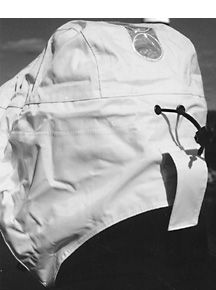It’s no fun to be caught out in a howler with foul-weather gear that leaks. Or if it does manage to keep the seas and rain out, there’s that clammy, wrapped-in-Saran feeling that makes you soggy, saps your strength, and leaves you feeling miserable.

The good news: Thanks to new waterproof breathable coatings, you don’t have to take it anymore. And—better news—you don’t have to pay the price for protection you did, say, 10 years ago.
In 1994, there was only one sure bet. It was—and is—called Gore-Tex, a waterproof fabric developed by W.L. Gore & Associates and engineered to breathe as well as protect. Gore-Tex is a “membrane” containing microscopic pores. It is surrounded by an abrasion-resistant outer fabric and a non-absorbent knit lining. The membrane is the key to the system, and the reason it works is because the membrane’s pores are small enough (20,000 times smaller than a raindrop) to keep water droplets out, but large enough (700 times larger than a water vapor molecule) to let the vastly smaller water vapor molecules pass through.
Amazing stuff, yes. But pricey. To luxuriate in the protection of a Gore-Tex foul weather jacket, you can expect to shell out $500 and more.
Today, there are alternatives. They go by the names of HellyTech (Helly Hansen), TP2000 (Henri Lloyd), Air-Tech (Ronstan), Hurricane (BoatU.S.), Epic (Chapin) and One (Two, Three, Four or Five) Dot (Gill)—the latter indicating fabric performance levels. With the exception of Epic, all are microporous fabrics whose properties are similar to Gore-Tex—they keep rain and seawater out while letting moisture caused by perspiration inside the garment escape. As we found, they deliver virtually the same protection and breathability as Gore-Tex but at a fraction of the price. Epic, made by Nextec, is the fabric of choice of professional sailor Dawn Riley, and is used in her signature collection for women by the Chapin Co. Engineered to work with lighter-weight soft shells in moderate weather, Epic differs from other applications by adding protection—no laminates, no coatings—inside the fabric, encapsulating the fabric’s fibers by wrapping them with silicone-based polymers. Since our interest was primarily in heavy-weather coastal or offshore gear, we didn’t have an opportunity to test this application.
So much for fabrics. Following are the jackets we tested—and why.
What We Tested
So we wouldn’t be comparing apples and enchiladas, we set criteria to level the playing field: All jackets had to be waterproof/breathable, suitable for coastal or offshore conditions, at least hip-length (to fit over the tops of shorts), include a stowable hood, reflective patch for overboard emergencies, and priced between $100 and $400. Upon first inspection, we discovered some other features our test jackets had in common: All came with a two-way, heavy-duty zipper with storm flap, Velcro-adjustable outer and inner/polyurethane wrist cuffs (except the Chapin Passage), drawstring-adjustable hoods, and fleece-lined collars. To increase ventilation and reduce condensation, all except two (Helly Hansen’s Voyage and Gill’s Coast) were also equipped with mesh liners.
Coastal vs. Offshore. If you tool around the bay or cruise primarily close to home, a coastal jacket will serve you best. Its lighter weight will be far more comfortable and easier to maneuver in than a heavy offshore jacket. And since “coastal” is the category that fits most boaters, you’ll also find a greater variety of styles, and better prices. On the other hand, if you race or cruise offshore, or make long coastal deliveries, or sail primarily in colder waters, you’ll need a jacket built to withstand harsh weather and breaking seas. In this report, we review several jackets in both categories—seven coastal, three offshore.
How We Tested
First, we timed how long it took us to get into the jacket (preparation), zip it up, secure all closures, and make all necessary adjustments to snug the jacket. With a squall approaching, you don’t want to spend a lot of time fooling with a plethora of drawstrings and an errant zipper.
Next, we determined—by doing a series of stretches, reaches, rotations, and bends—how easy or difficult it was to move around in the jacket. We then performed a two-tier water-repellency test: We first stood under a shower for three minutes (to simulate a heavy rain). We then had a friend get on the working end of a garden hose (15 pounds pressure) to pelt us, for another three minutes, with intermittent blasts of water (to simulate breaking seas). Not terribly scientific, but it told us what we needed to know. Last, we hit the treadmill for 15 minutes, worked up a sweat, then checked for signs of unevaporated moisture inside to determine the effectiveness of the jacket’s breathability. You can see how each jacket fared in our Value Guide above.
What We Found
Chapin Passage: Traditional waterproof jackets will keep you dry during a downpour. Unfortunately, they also tend to be crinkly. The Passage, however, is a soft-shell jacket. In fact, its outer fabric is so soft you’ll think you’re wearing an all-weather garment. The jacket is waterproof/breathable (Teflon fabric protection, two-layer laminated membrane) and comes with tricep vents, two outside fleece-lined zipper side pockets, two inside pockets, a front-zipper double storm flap, Velcro-adjustable outer wrist cuffs, an adjustment on the back of the hood to tailor fit, and a neoprene “half-glove” that’s built into the wrist cuff.
Likes: Soft outer fabric, fleece-lined pockets, light weight.
Dislikes: That half-glove, sewn into the jacket’s wrist liner, is designed to anchor the sleeve to your arm and keep water out when reaching overhead. Unlike other jackets, wrist adjustment doesn’t require a two-step operation—tightening an inner wrist cuff, then an outer wrist cuff. Great in theory, and the half gloves do keep the sleeve from riding back, but the hole cutouts for the thumb and fingers aren’t snug enough to keep water out.
Although the size of the side pockets was generous, entry size was not, and with both a Velcro and zipper closure to deal with, they required some contortions to get into. Simple cargo pockets, to our mind, would be a better alternative. Also, the jacket comes with only one reflective patch—on the back—which we think is inadequate.
Gill Coast: This jacket uses Gill’s Two Dot (inshore/coastal) two-layer nylon breathable fabric and includes double-seal cuffs, zipped and fleece-lined outer side pockets, internal zipper pocket, articulated arms, drawstring hem adjustment, and reflective patches on the front placket and hood.
Likes: Fleece-lined pockets to warm hands. The articulated arms permitted plenty of movement.
Dislikes: The zipper is small. It was difficult to snug the hood to the face. The side pockets were too small; larger cargo pockets would be an improvement.
West Marine Explorer: This offshore jacket is suited for hard work in chilly and rough conditions. It includes a rugged coated nylon waterproof/breathable outer fabric, a double storm flap zipper closure, reflective piping and patches on the chest, shoulders and hood (which includes an adjustment at the back to customize fit), four outside pockets (two cargo pockets with side-entry fleece-lined handwarmer pockets), one zippered inside pocket, abrasion patch on the seat of the jacket, non-corroding zipper, and drawstring adjustments at the hemline and waist.
Likes: The heft and durability of this jacket made it seem virtually bullet-proof. A drawstring gaiter on the inside perimeter of the hood can be snugged to the face to keep water out. The zipper, as on all offshore jackets we tested, was hefty and easy to grasp.
Dislikes: Although there are four exterior pockets, the upper two are too small to be very useful. Although not a dislike, we would advise readers to make sure they need a jacket of this heft and protection. It would probably be overkill for casual sailing.
Ronstan Inshore: This snappy-looking jacket (red/navy with white accents) comes with an Air-Tech waterproof/breathable fabric, double storm flap and drainage channel, two outside cargo pockets, and one inside pocket (plus a zippered pocket behind the storm flap).

Likes: Multiple reflective patches on the front, shoulders and hood will enhance visibility in MOB situations. Fleece handwarmer sections on the outside of the pockets are quick to access. Generous-sized zipper.
Dislikes: The cargo pockets are small. The outer sleeve had to be pulled up to get to the inner wrist adjustment.
Musto MPX Gore-Tex Coastal: As you’d expect in a jacket costing $395, this one comes with plenty of bells and whistles. Included are a Gore-Tex laminate outer, two fleece-lined cargo pockets, one inside mesh pocket, double storm flap and drainage channel, reflective patches at the chest, shoulders and wrists, and a high-visibility fluorescent mesh-lined hood that requires a tug on only one drawstring to snug it to the face.
Likes: Drawstring adjusters at the hood and collar were a snap to use. The hood conforms to the head well and, like some others, includes a Velcro-strip adjustment at the back to further customize fit. Generous-sized zipper.
Dislikes: Like the Ronstan, it was necessary to hike the sleeve up to get to the inner wrist adjustment. Other than that—and the price—we found very little not to like.
Henri Lloyd Rapid Coastal: Lots of goodies in this jacket. To name a few: TP2000 waterproof/breathable fabric, multi-adjustable fluorescent hood, face-protection collar, two cargo pockets with exterior fleece handwarmer pockets, one inside pocket, reflective patches at the hood and shoulders, and drawstring adjustments at waist, hood and collar.
Likes: The hood-and-collar system is downright ingenious. The hood includes multiple drawstring adjusters, positioned in the right place for easy access to customize fit and allow the hood to move with your head. Drainage channels are built into the hood’s peak to allow water runoff. The inside of the hood includes a gaiter that snugs to your face to keep the elements out. The collar includes a Velcro-attached polyurethane chin flap that can be pulled over your lower face for protection and warmth. The zipper, generous in size, was somewhat shorter than others tested, which made it easier to engage without the need to bend over.
Dislikes: The jacket could use more pockets.
BoatU.S. Hurricane: You want pockets? This offshore jacket has six of them—four cargo pockets outside (with side-entry fleece handwarmer slots) and two zip pockets inside. There’s also a fleece-lined fluorescent hood, abrasion patches at the elbows, reflective patches at the shoulders, wrists, hood, and chest (plus reflective piping on the chest), a high nylon collar (with protective chin flap), zippered under-arm vents, drawstring adjustments at the hood, collar, bottom and waist, and a double storm flap over the zipper.
Likes: This jacket delivers a lot for the money, with more features than most.
Dislikes: Even though this jacket is designed for extremes, we found the heavy–duty oxford nylon fabric too stiff and crinkly for our taste. Also, the collar was too tall, making it difficult to turn the head. We also found it difficult to snug the collar and attach the chin flap (the Velcro adjustments didn’t line up).
Finally, the jacket did not fit particularly well; even though we cinched up all drawstrings to snug the fit, voids remained near the head where water can enter.
We tried out this jacket at about the same time as the announcement came that West Marine would be taking over BoatU.S. retail operations. As of this writing the jacket is not for sale online at BoatU.S., but there may still be some for sale in BoatU.S. stores.
Helly Hansen Voyage: Among the jackets we tested, this was the only one with a polyamide taffeta lining, rather than mesh. Does it work to prevent condensation buildup? Not as well as others, according to our tests. But this jacket has other redeeming features, namely a HellyTech waterproof/breathable outer fabric, drawstring adjustment at the collar, hood, bottom, and waist, a double storm flap, and straps for an inflatable PFD.
Likes: Its simplicity and light weight.
Dislikes: The hood’s drawstrings were difficult to adjust, the hood had no adjustment for head shape (the bill was constantly in our eyes), and the front zipper was small and difficult to grasp. There was paucity of reflective patches (only one, at the chest) and a prominence of logos. The seam under one arm leaked during our water-repellency test.
Gill Key West: This jacket uses Gill’s Three Dot (coastal/offshore) micro-porous two-layer nylon/breathable fabric. It comes with an offshore-height collar (with chin flap), fluorescent hood, two cargo pockets with fleece handwarmer pockets, one inside pocket, two-way zipper with double storm flap, drawstring adjustment on the hood and hem, and reflective patches on the hood, chest, and shoulders.
Likes: Nice fit, with plenty of freedom of movement. Like the Musto MPX Coastal, the hood includes a Velcro adjustment at the back to raise or lower the bill and customize fit. Generous-sized zipper.
Dislikes: The collar, designed more for offshore use, was too tall for our taste. After adjusting the hood’s drawstrings, our head could move but the hood wouldn’t.

Gill Atlantic: A heavier jacket for offshore use, this model has all the features of Gill’s Key West coastal jacket, differing only in its outer fabric (Four Dot three-layer non-porous nylon), drawstring adjustment at the waist, abrasion patches at the elbows and wrists, and triple- drawstring adjustment on the hood to tailor fit.
Likes: The greater heft and sturdiness of this jacket, despite its somewhat soft (for an offshore jacket) fabric, convinced us that it’s up to rough work offshore. Easy-to-engage zipper.
Dislikes: The hood’s drawstrings were a bit difficult to adjust and did not allow a snug fit around the face.
Conclusions
This was a close call. Although we recorded different scores in waterproof/breathability for the jackets we tested, the differences, in fact, were not very pronounced. No fabric was so superior that it clearly outshined the rest—and that, as we suggested at the outset, is good news. The true key to success here is longevity, and for that we’ll have to rely on reports from readers. Don’t hesistate to write.
We did have some favorites and—better news—they weren’t the most expensive. Nor were they the least expensive, but to us they represented the best value for the price.
Our top pick in coastal jackets was the Henri Lloyd Rapid Coastal—for its quick and easy-to-use hood and collar adjustments, easy-engage zipper, polyurethane chin flap, abundance of drainage channels, and for its overall test performance
Runner-up was Ronstan’s Inshore. We liked this jacket’s easy-access handwarmer pockets, its abundance of reflective patches, its easy-grasp oversize zipper, and its waterproof/breathable performance (among the best of the jackets we tested). We also liked its price, $150 less than the Henri Lloyd. So it’s our Best Buy.
In offshore jackets, the Gill Atlantic was—despite its price—our hands-down favorite. This jacket’s well-located abrasion patches, soft but tightly woven fabric, easy-to-engage zipper, and overall performance scores set it apart for deep-water use.
Also With This Article
Click here to view “Value Guide: Foul Weather Jackets.”
Contacts
Chapin, 866/888-8682, www.chapincompany.com
Gill, 770/945-0564, www.gillna.com
Helly Hansen, 800/435-5901, www.hellyhansen.com
Henri Lloyd, 800/661-5696, www.henrilloyd.com
Musto, 011-44-0-1268-495830, www.musto.co.uk
Ronstan, 727/545-1911, www.ronstan.com/marine
West Marine, 800/BOATING, www.westmarine.com
































